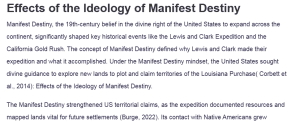Effects of the Ideology of Manifest Destiny
Manifest Destiny, the 19th-century belief in the divine right of the United States to expand across the continent, significantly shaped key historical events like the Lewis and Clark Expedition and the California Gold Rush. The concept of Manifest Destiny defined why Lewis and Clark made their expedition and what it accomplished. Under the Manifest Destiny mindset, the United States sought divine guidance to explore new lands to plot and claim territories of the Louisiana Purchase( Corbett et al., 2014): Effects of the Ideology of Manifest Destiny.
The Manifest Destiny strengthened US territorial claims, as the expedition documented resources and mapped lands vital for future settlements (Burge, 2022). Its contact with Native Americans grew through wrongfully superior understandings of cultural differences, leading to eventual land fights. Lastly, the expedition motivated people to move west because its discoveries showed unlimited potential in western regions, which pushed Americans to think they had to fill and expand their nation westward.
Similarly, the California Gold Rush of 1849 was heavily influenced by Manifest Destiny. Its beliefs let more settlers move to California to pursue wealth and claimed the US held total rights to use its resources. This westward migration accelerated California’s path to statehood, furthering the expansionist goals of Manifest Destiny. It also disrupted Indigenous populations, leading to the displacement and decline of Native communities due to land seizures and violence (Chávez, 2024).
Additionally, the Gold Rush expanded the US economy worldwide through its trading activities in California while following its belief that westward growth would result in prosperity and progress for everyone. By using the Manifest Destiny concept, these events illustrate how expansionist beliefs drove American development but also generated numerous challenges and conflicts. While the advantages of territorial growth were clear, the harm caused to Native communities and the connection among people remains critical aspects to reflect upon.
References
Burge, D. J. (2022). A failed vision of empire: The collapse of manifest destiny, 1845-1872. University of Nebraska Press.
Chávez, E. (2024). Review: A failed vision of empire: The collapse of manifest destiny, 1845–1872, by Daniel J. Burge. Pacific Historical Review, 93(1), 154–155. https://doi.org/10.1525/phr.2024.93.1.154
Corbett, P. S., Janssen, V., Lund, J. M., Pfannestiel, T., Waskiewicz, S., & Vickery, P. (2014). U.S. history. OpenStax. https://openstax.org/books/us-history/pages/11-1-lewis-and-clark
ORDER A PLAGIARISM-FREE PAPER HERE
We’ll write everything from scratch
Question 
Required Resources
In your American History course, you will utilize scholarly sources to address questions in the weekly assignments. Please be advised that History.com, Wiki, Wikipedia, or websites such as cliffnotes.com, studymode.com, coursehero.com, and the like are not deemed scholarly sources. Therefore, use your course text and incorporate an additional scholarly source from the Chamberlain Library in your response.
Below is a list of resources you must choose from:
- Textbook: Chapter 11
- Lesson
- Minimum of 1 scholarly source from the Chamberlain Library resources below:
- Sources for the Week 3 Discussion are available by accessing this link.Links to an external site.
- The “Popular Data Bases” within the Library Guide for scholarly sources and videos via Search Popular History DatabasesLinks to an external site. or the History Library GuideLinks to an external site..

Effects of the Ideology of Manifest Destiny
Initial Post Instructions
In preparation for the initial post, consider two (2) of the historical selections below:
- The Lewis and Clark Expedition
- The Missouri Compromise
- Independence of Texas
- Mexican War of 1846–1848
- The California Gold Rush
Then, in one (1) to two (2) paragraphs, address one (1) of the following:
- Which of your two selections do you consider most impactful on Westward Expansion during 1800–1848? Explain why.
- Analyze the effects of the ideology of Manifest Destiny on the two historical events that you chose from the list above.